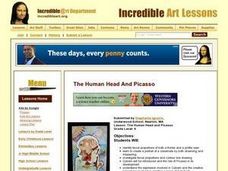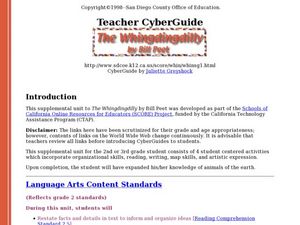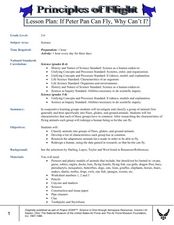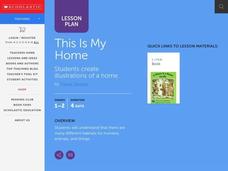Curated OER
The Human Head and Picasso
Sixth graders view human head paintings by Picasso. Using the paintings, they identify the facial proportions by a frontal and profile view. With a partner, they create a portrait of them after observing and measuring their face. They...
Curated OER
Shark Attack
Students study the white shark and the red triangle. In this critical thinking lesson students assess the validity of facts about sharks and create a public service announcement either promoting shark or human protection.
Curated OER
Sizing Up the Supersize Croc
Middle schoolers examine and compare traits of humans and crocodiles. In this crocodile lesson students use a ratio to estimate the height of a person and compare that to a crocodile.
Curated OER
The Whiningdingdilly
Students read the book The Whiningdingdilly and complete a Venn Diagram, write a friendly letter, find misplaced animals, and morph animals and humans. In this The Whiningdingdilly lesson plan, students practice reading, writing, map...
Curated OER
Mammal Morphology - Bats, People, and Other
For this physical characteristics worksheet, students compare bats and humans by putting a + sign in the chart for whether or not bats and humans have the same characteristics. Students do this for 17 characteristics and answer 3 questions.
Curated OER
If Peter Pan Can Fly, Why Can't I?
Students redesign a human, using data in research, so that s/he can fly. For this flying lesson, students examine the characteristics and adaptations of groups of animals that can fly. Using this research, students work...
Curated OER
This Is My Home
Students listen to a read aloud of Mary Ann Hoberman's A House Is a House for Me before discussing the meaning of habitats and the different types of homes that people live in. Next, they pretend to be architects and design a home for...
Curated OER
Human Embryology
Ninth graders are introduced to the concept of human embryology. Individually, they complete an exercise in which they determine which trait they got from which family member. In groups, they identify and label the reproductive organs...
Curated OER
Payload Rocket
Students continue their examination of how to make a human presence in space. Using Newton's Laws of Motion, they discover the difference a rocket's payload affects the launch of a rocket. They develop a balloon rocket and test its...
Curated OER
In Search of Human Origins, Part II
High schoolers watch a video about the search for human origins. Using a worksheet, they identify the data trends in height of boys in North America. They discuss the significance of the data and the reasons for the increase of human...
Curated OER
America's Underwater Treasures Viewing Guide
Students complete a worksheet while watching a video about how humans affect the ocean environment. They discover the need for a practice of balancing fisheries and their fishing practices. They examine how scientists use data to help...
Curated OER
The Gulf of Maine
Young scholars examine the effect of limiting factors, especially when it comes to human beings. They examine data from the Gulf of Maine area.
Curated OER
Managing Wildlife
Young scholars explore the relationship between wildlife and humans in northern New England. They also brainstorm ideas on why they think some species are greater in population than others in a given area.
Curated OER
Why Study Air Pollution?
Eighth graders study air pollution and identify some causes, effects and solutions. In this air pollution activity students complete several activities.
Curated OER
Stormy Weather
Fifth graders compare human and wildlife environments. In this stormy weather activity, 5th graders imagine they are an animal or human during a storm. Students compose a story with comparisons and reasons for how an...
Curated OER
The Puzzle of the Ice Age Americans
Students describe alternative theories for how the first humans cane to America. In this human origin lesson students study the origins of the first Americans.
Curated OER
The Food Pyramid
Students determine that humans need food to function properly. In this nutrition lesson, students discuss the food categories used in the food pyramid by charting the foods eaten in one day.
Curated OER
By Land or by Sea...or Both?
Learners research a video and participate in a discussion. In this watercraft lesson students review material and answer questions about what they learned.
Curated OER
Living and Non-Living
Students discover the basic needs of life. In this science lesson plan, students explore how all living things need air, water, food and shelter
Curated OER
If I Was A...? Mother Nature
In this environment worksheet, students pretend they are Mother Nature as they answer 4 questions. They explain whether their temperature gets hotter with a fever, why the Ozone layer is leaving them, how big Mother Nature is compared to...
Curated OER
Life Processes and Living Things-Humans and Other Animals
In this fill in the blank worksheet, students respond to 20 short answer questions by identifying foods that contain large amounts of sugar, carbohydrate, and fruit acids and explaining their effects on the body.
Curated OER
The Battle Between Dragons and Humans
In this social studies learning exercise, students find the words related to the literature with dragons. The answers are found by clicking the button at the bottom of the page.
Curated OER
Human Development
Students are introduced to the stages of human development. In groups, they research the theories of Erickson, Maslow and Havighurst and compare them to one another. To end the instructional activity, they present their material to the...
Curated OER
Geologic Time Scale
Students recreate and comprehend the geologic time scale. They discuss how long humans have been around on Earth. Students are shown the geologic time scale and its different parts. They work in groups to recreate the time scale.

























